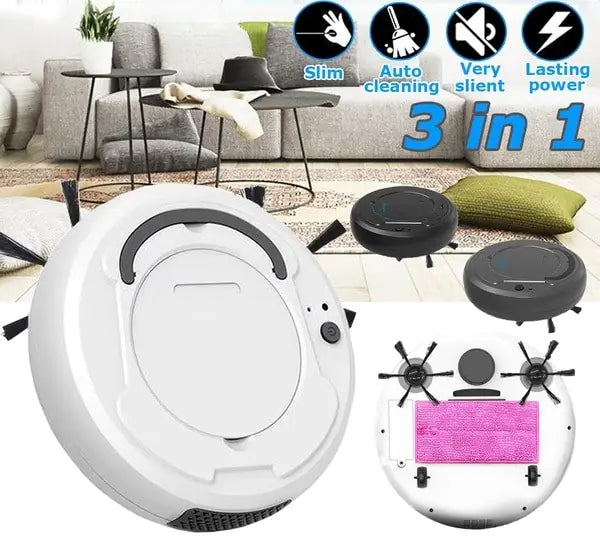Description
A Robot Vacuum Cleaner is a highly versatile cleaning device that provides an effortless, automated solution to maintaining a clean home. With its compact, intelligent design and advanced technology, it can navigate around your home to vacuum floors, suck up dust and debris, and even clean in hard-to-reach places—without the need for direct human intervention. Robot vacuums are increasingly popular for their convenience, especially in busy households or for those who want to minimize the time spent on cleaning.
Key Features of a Robot Vacuum Cleaner:
Autonomous Cleaning: Robot vacuums are designed to clean your home autonomously. Once programmed, they can start cleaning at a scheduled time and return to their charging dock once the task is completed, all without you needing to lift a finger.
Smart Navigation: Advanced robot vacuums use sensors and navigation systems (such as LIDAR, cameras, or infrared) to map your home and navigate it effectively. Some even use AI to adapt to the environment, detecting obstacles and adjusting their path for optimal cleaning coverage.
Multiple Cleaning Modes: Robot vacuums often offer several cleaning modes such as edge cleaning, spot cleaning, and auto cleaning to tackle different areas or specific messes. Many models can also increase suction power in specific spots or on carpets.
Efficient Cleaning Pathways: Unlike traditional vacuum cleaners that may clean in random patterns, robot vacuums are designed to follow efficient cleaning paths. This means they can cover large areas systematically, ensuring nothing is missed.
High Suction Power: Many robot vacuums are equipped with powerful suction technology to capture dirt, dust, and debris from various floor types, including hardwood, carpet, tiles, and rugs. Some models even have adjustable suction power for different surface types.
Low-Profile Design: The compact, low-profile design of most robot vacuums allows them to easily maneuver under furniture, such as beds, couches, and tables, where dust and debris often accumulate.
Dirt Detection Sensors: Some robot vacuums come with dirt detection sensors that automatically detect areas with higher dirt levels and adjust the suction or cleaning mode for more focused cleaning.
App Control & Smart Home Integration: Many modern robot vacuums can be controlled via a smartphone app. This allows you to schedule cleaning times, monitor cleaning progress, and adjust settings remotely. Some models are also compatible with voice assistants like Amazon Alexa and Google Assistant, allowing you to control them using voice commands.
Self-Charging: When a robot vacuum’s battery is low, it automatically returns to its charging station to recharge, ensuring it’s always ready for the next cleaning session. Some high-end models can clean an entire floor before needing a recharge.
Large Dustbins and HEPA Filters: Many robot vacuums have large dustbins that can collect a significant amount of dirt before needing to be emptied. Some models also feature HEPA filters, which are great for trapping allergens and improving air quality in your home.
Benefits of Using a Robot Vacuum Cleaner:
Convenience: The primary benefit of robot vacuums is their convenience. You don’t have to push a heavy vacuum around or spend time cleaning—simply set it and let it clean while you focus on other tasks.
Time-Saving: Robot vacuums save you time by cleaning your floors while you’re away or when you’re busy doing other things. You can schedule the cleaning process so that your home is always fresh and tidy without you having to be involved.
Consistent Cleaning: Because they run on a set schedule or when prompted, robot vacuums maintain consistent cleaning throughout the week. This makes them excellent for maintaining a dust-free environment in high-traffic areas or homes with pets.
Ideal for Busy Lifestyles: If you have a hectic schedule or a large household, a robot vacuum can be a lifesaver, performing cleaning tasks while you’re at work, on errands, or relaxing at home.
Pet Hair Removal: Many robot vacuums are designed to pick up pet hair, which can be a challenge for traditional vacuums. With specialized brushes and powerful suction, these vacuums are great for homes with pets.
Multi-Surface Cleaning: Whether it’s hardwood, tiles, or carpet, robot vacuums can handle various surfaces effectively. Some models even adapt their cleaning methods based on the type of surface they are cleaning.
Low Maintenance: Robot vacuums require minimal maintenance. You may need to clean the brushes occasionally and empty the dustbin, but they are otherwise self-sufficient, saving you effort compared to manual cleaning.
Allergen Reduction: With their ability to collect dust, dirt, and pollen, many robot vacuums are beneficial for people with allergies. Models equipped with HEPA filters help trap allergens, leading to better air quality in the home.
Types of Robot Vacuum Cleaners:
Basic Robot Vacuums: These offer simple features such as random navigation and scheduled cleaning but may not have advanced mapping or app control.
Example: Eufy RoboVac 11S.
Mid-Range Robot Vacuums: These have better suction power, more intelligent navigation systems (such as room mapping), and features like app control.
Example: iRobot Roomba 960, Shark IQ Robot.
High-End Robot Vacuums: These models feature advanced AI-powered navigation, LIDAR mapping, more suction power, long battery life, and are integrated with smart home systems. They offer features like automatic dirt disposal and specialized cleaning modes.
Example: iRobot Roomba s9+, Roborock S7, Neato Botvac D7.
Robot Mop Vacuums: These robots offer the dual functionality of vacuuming and mopping. They are ideal for homes with hard floors that need regular cleaning.
Example: iRobot Braava Jet m6, Roborock S7 (mopping + vacuuming).
Popular Brands and Models:
iRobot Roomba:
One of the most well-known brands in the robot vacuum market, iRobot offers various models with different features, from basic cleaning to high-end models with advanced mapping and self-emptying capabilities.
Example Models: Roomba 675 (affordable), Roomba i7+ (self-emptying), Roomba s9+ (premium model).
Roborock:
Roborock offers excellent performance, especially with its models that provide both vacuuming and mopping. They are known for strong suction, intelligent navigation, and long battery life.
Example Models: Roborock S5 Max, Roborock S7 (with mopping feature).
Shark:
Shark’s robot vacuums are known for affordability and powerful suction, with self-cleaning brushes and effective pet hair collection.
Example Models: Shark IQ Robot, Shark Ion Robot.
Neato Robotics:
Neato vacuums feature a D-shaped design for corner cleaning and are known for their effective navigation and excellent suction.
Example Models: Neato Botvac D7, Neato Botvac D4.
Ecovacs Deebot:
Ecovacs offers affordable, yet feature-rich robot vacuums, with strong suction and mopping capabilities in some models.
Example Models: Deebot Ozmo T8 AIVI, Deebot N79S.
How to Choose the Right Robot Vacuum Cleaner:
Floor Type: Choose a robot vacuum that works well with the floor types in your home. If you have carpets, look for a model with powerful suction. For hardwood floors, most models should be sufficient.
Suction Power: Strong suction power is essential, especially if you have pets or carpets that trap dirt and hair.
Navigation System: If you have a complex home layout or want precise cleaning, opt for a model with advanced navigation (LIDAR, smart mapping).
Battery Life: A longer battery life ensures that the vacuum can clean larger areas without needing a recharge.
Smart Features: Consider if you want a model that integrates with smart home devices, offers app control, or can be scheduled remotely.
Noise Level: While most robot vacuums are quieter than traditional ones, check the noise level if you prefer a quieter cleaning session.
Price Range: Robot vacuums range from affordable models to premium ones. Determine your budget and choose a vacuum with the features that best meet your cleaning needs.

















Reviews
There are no reviews yet.